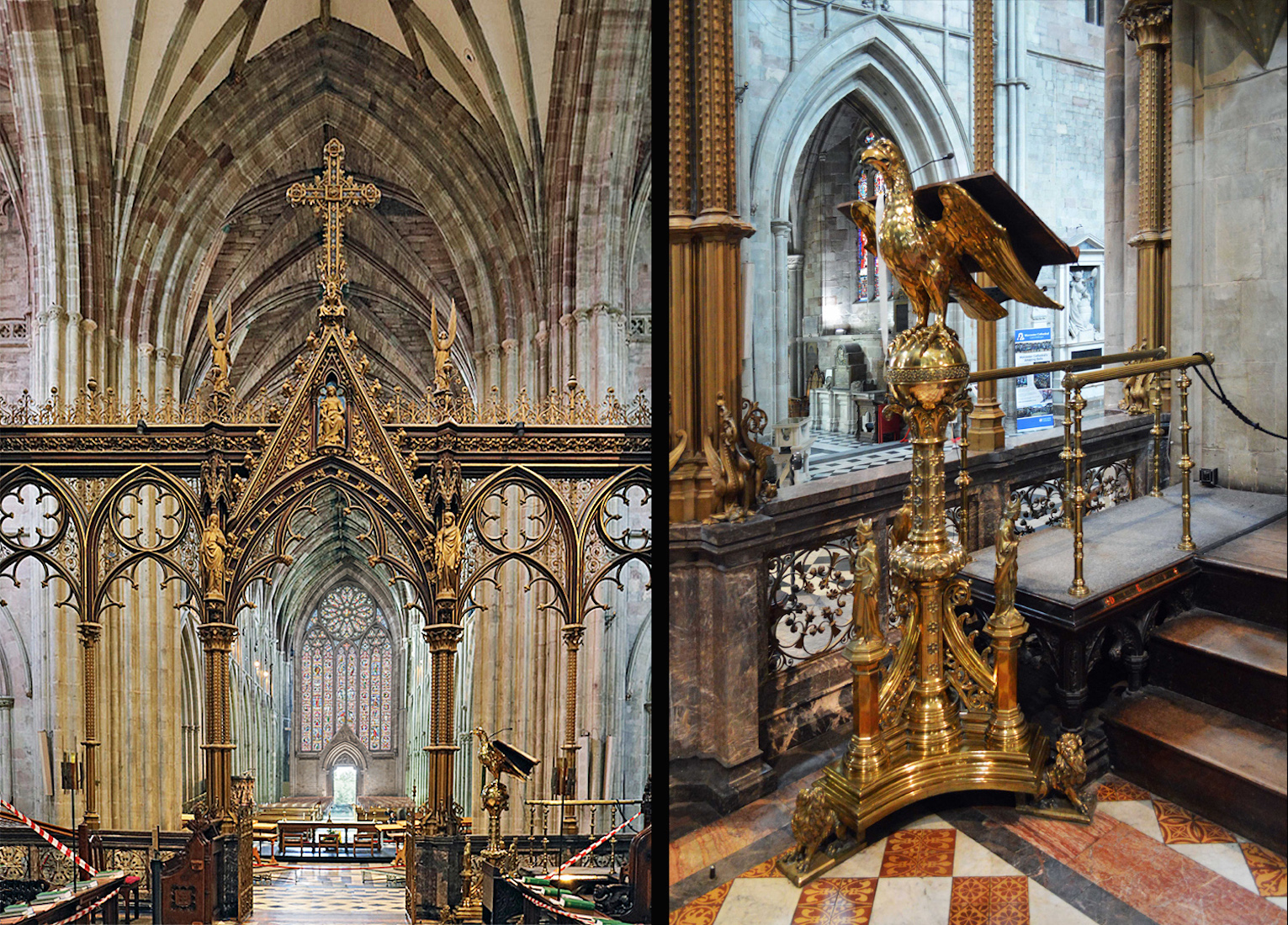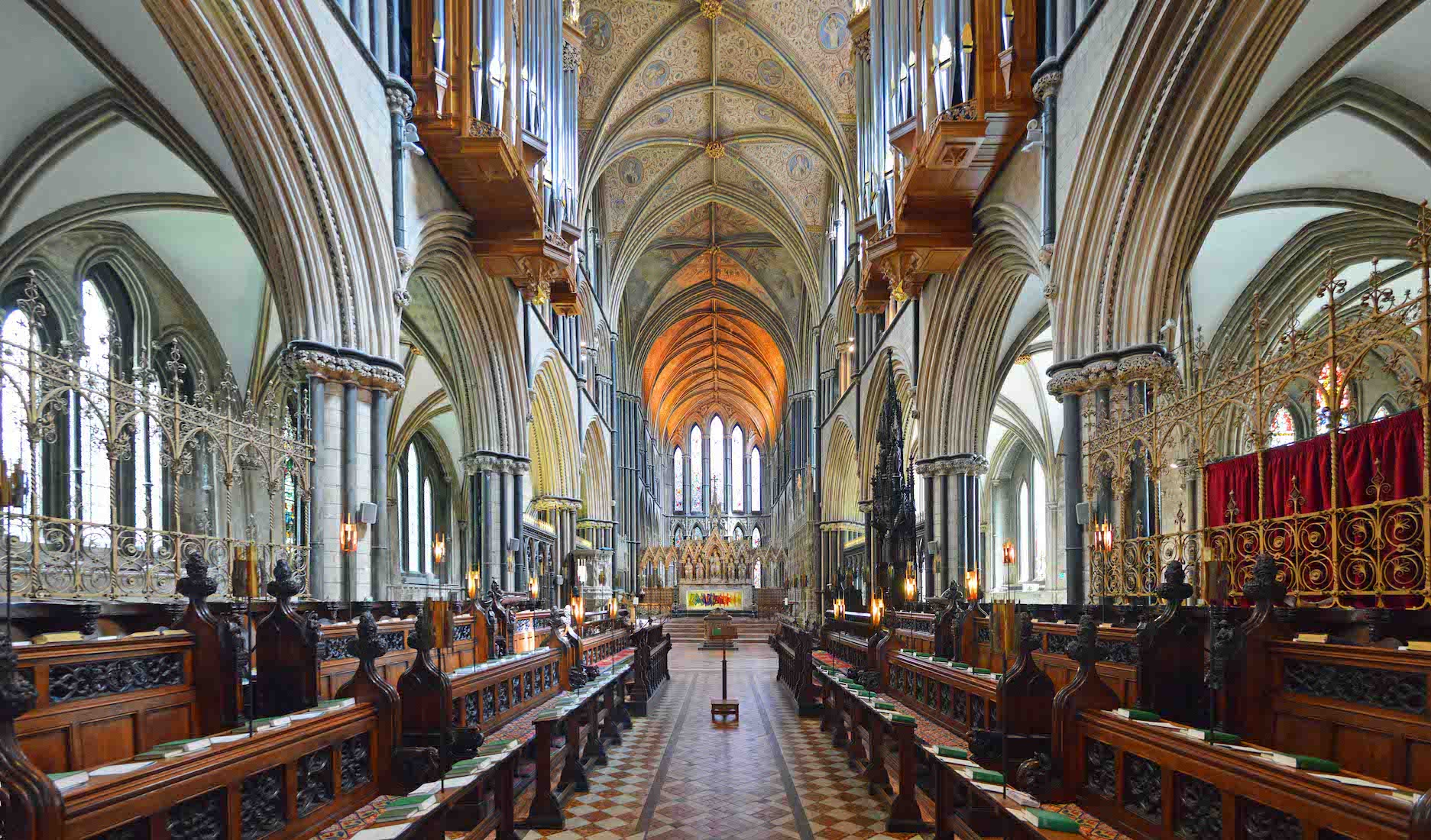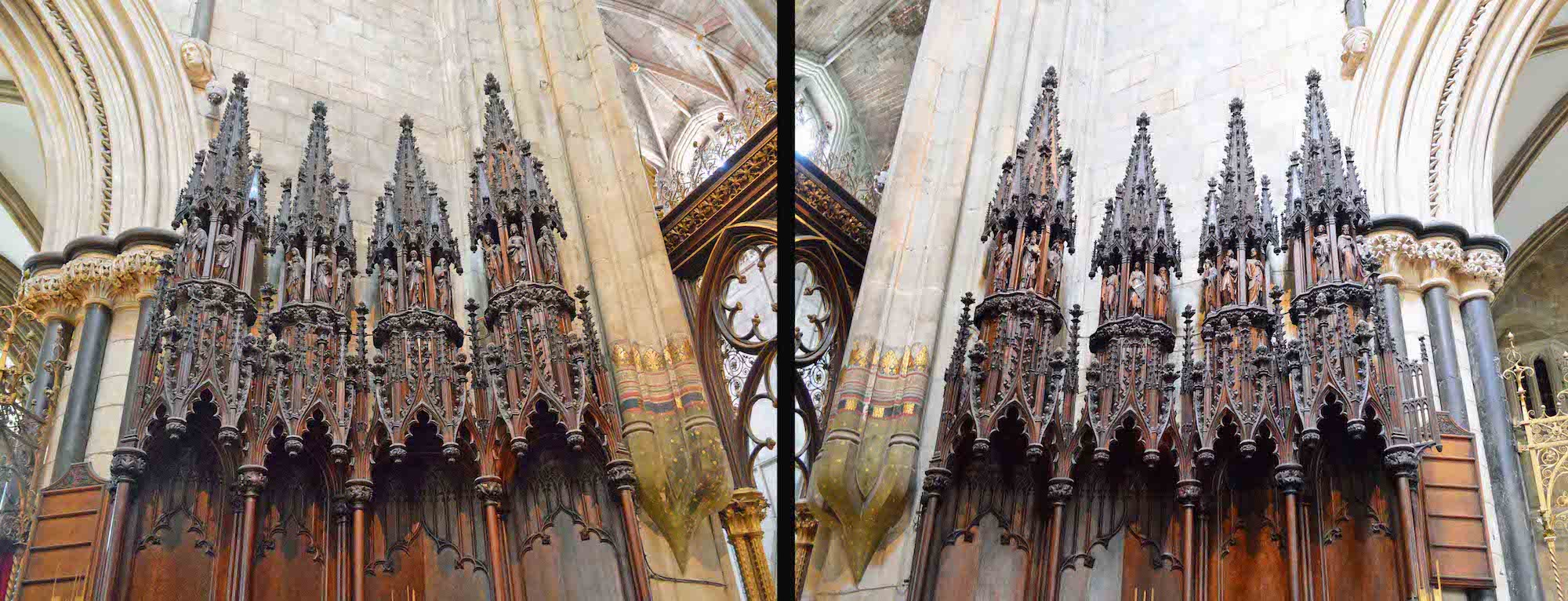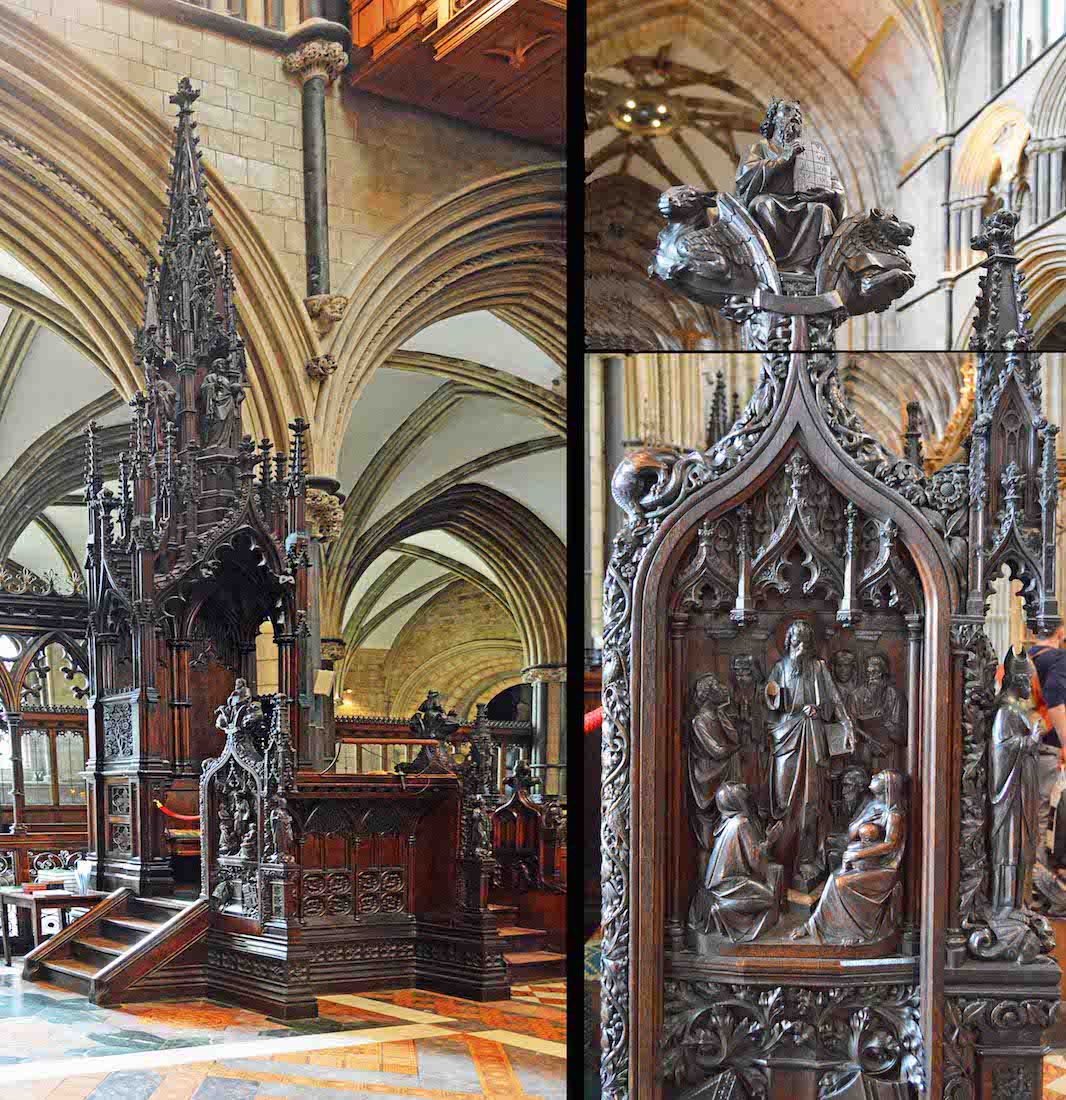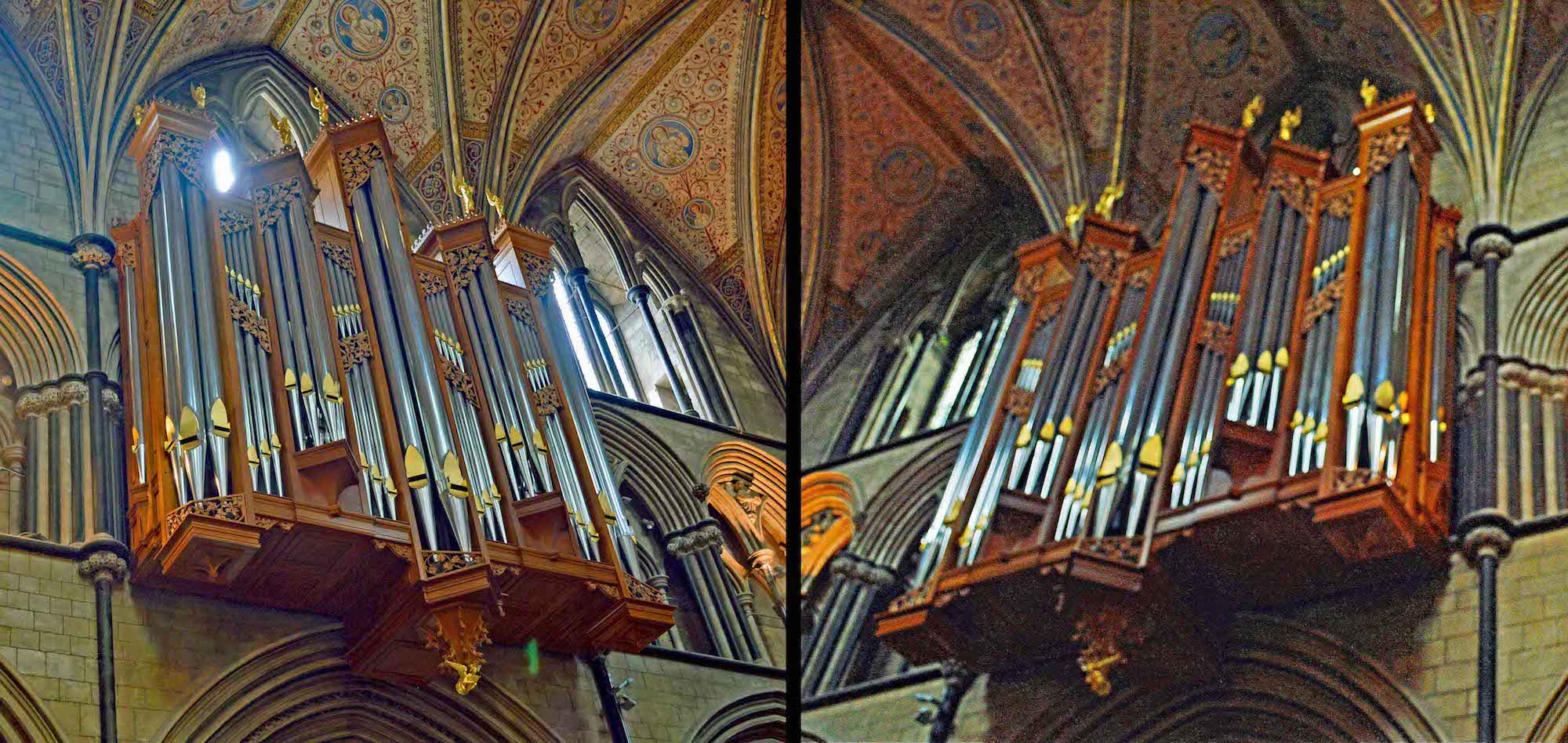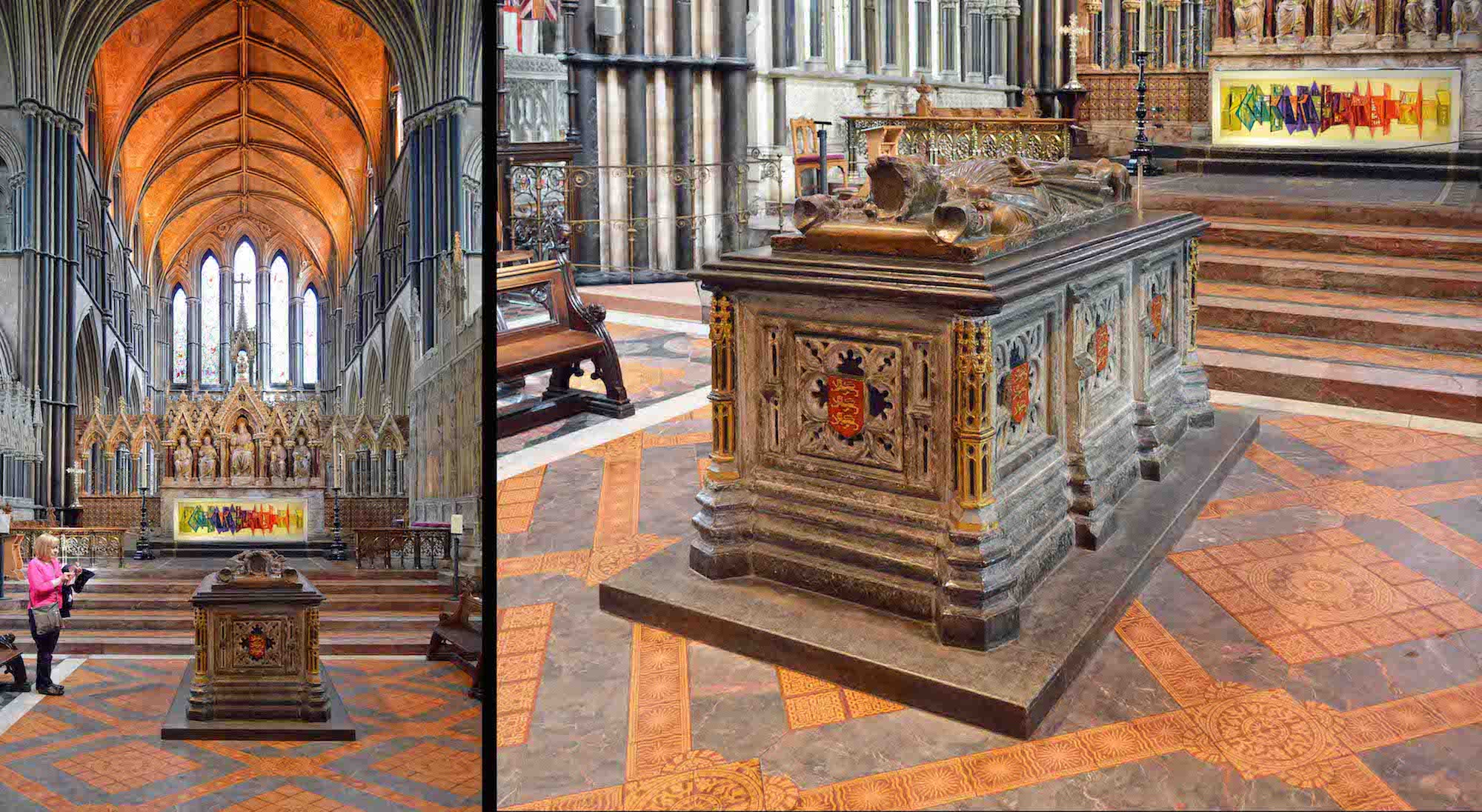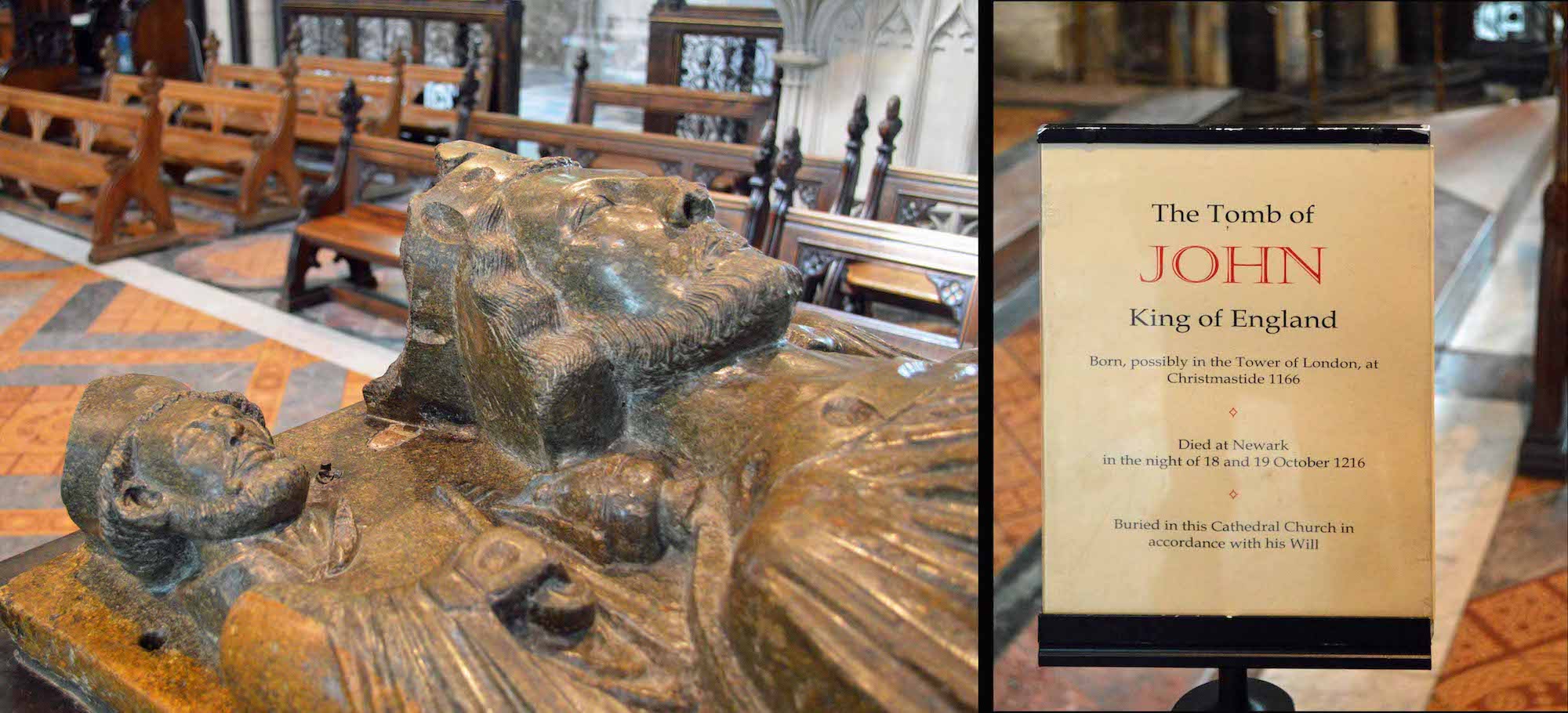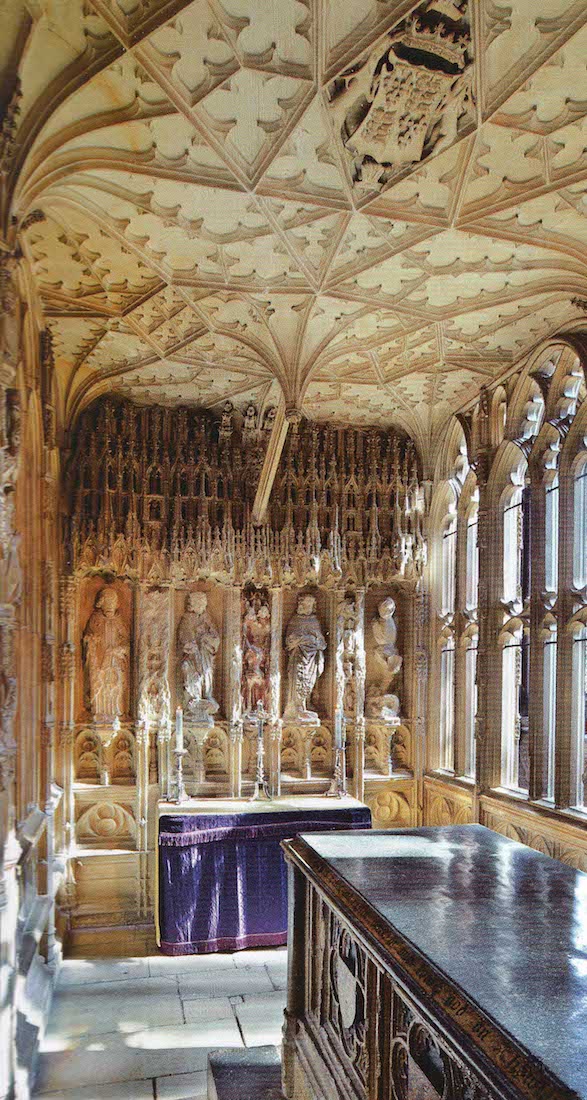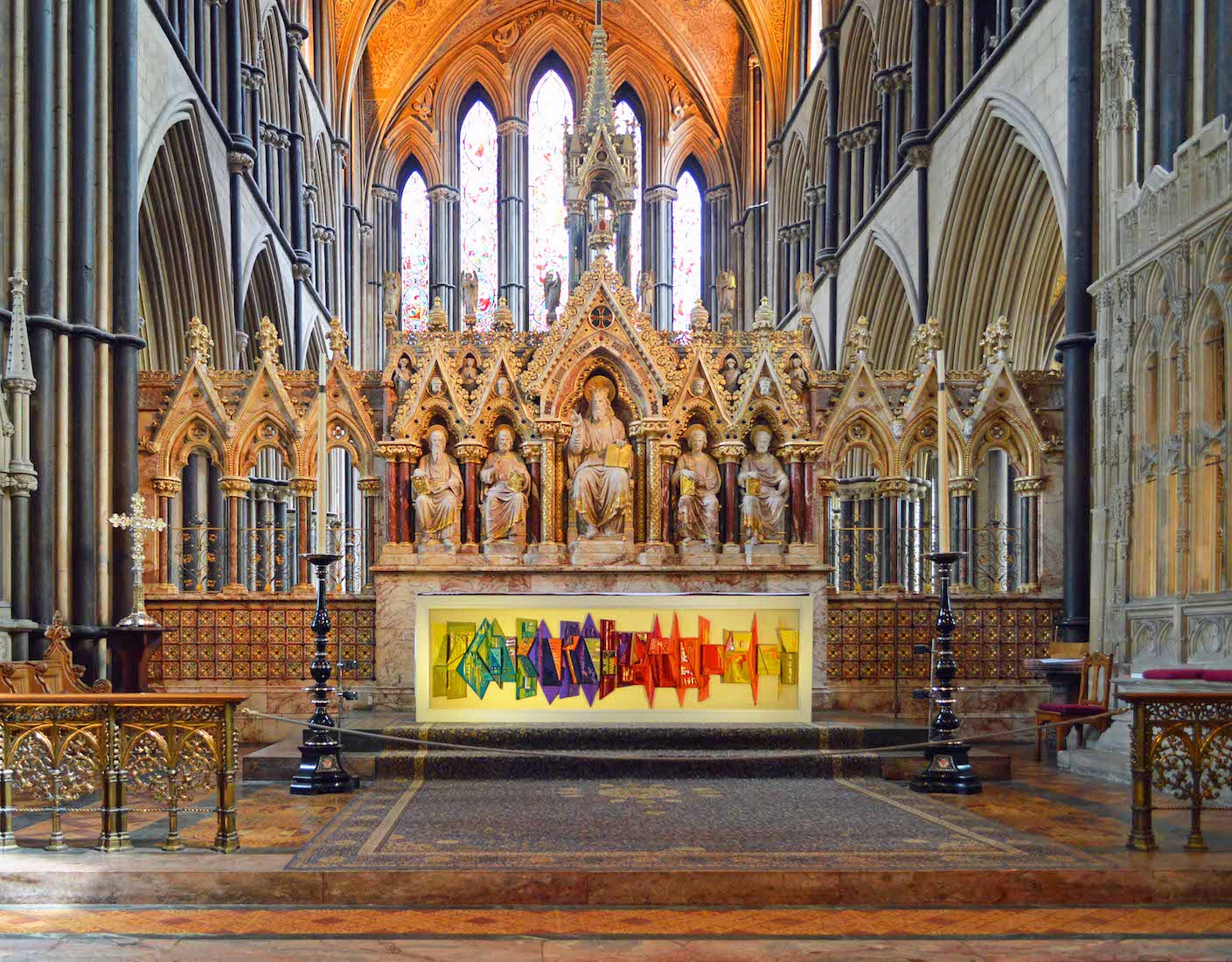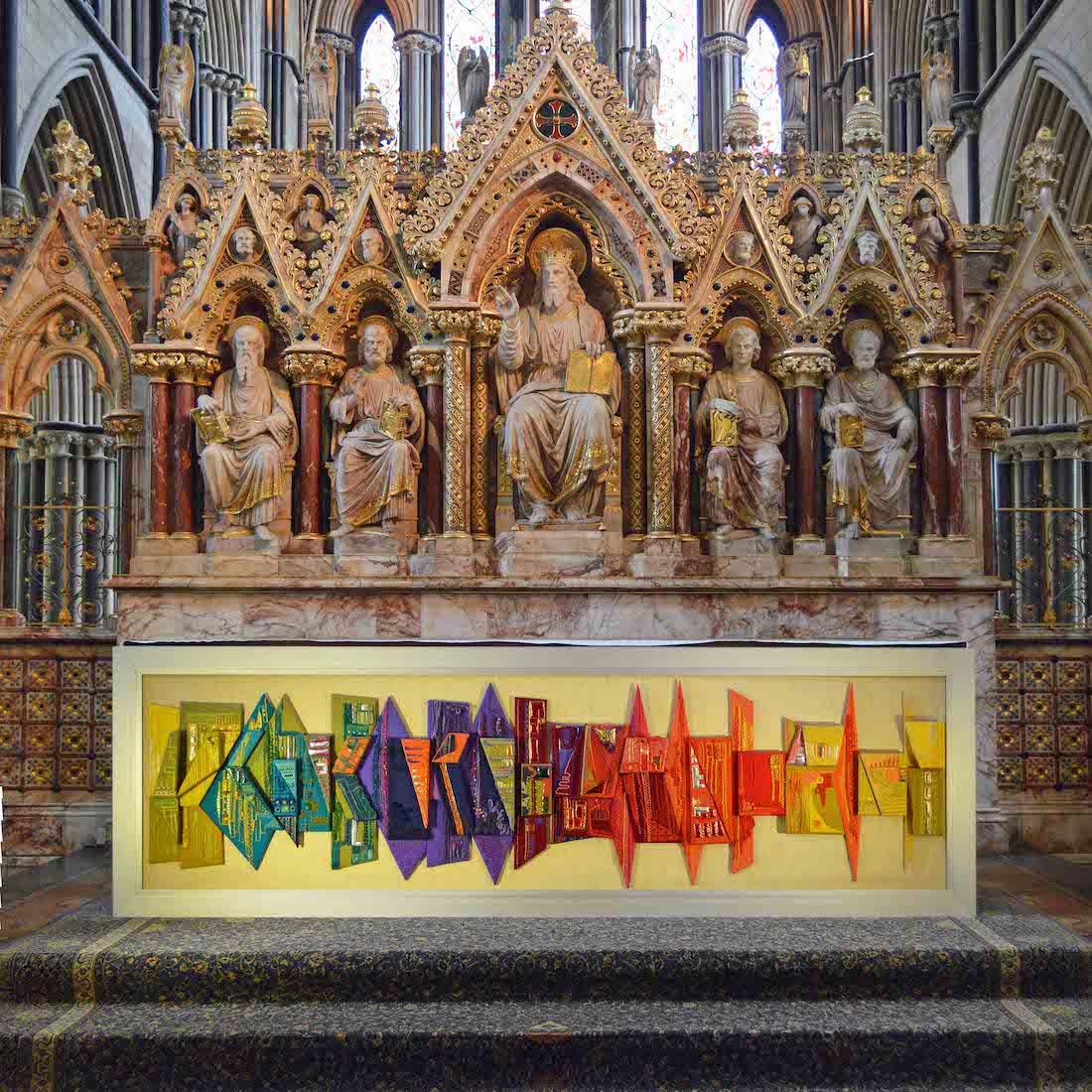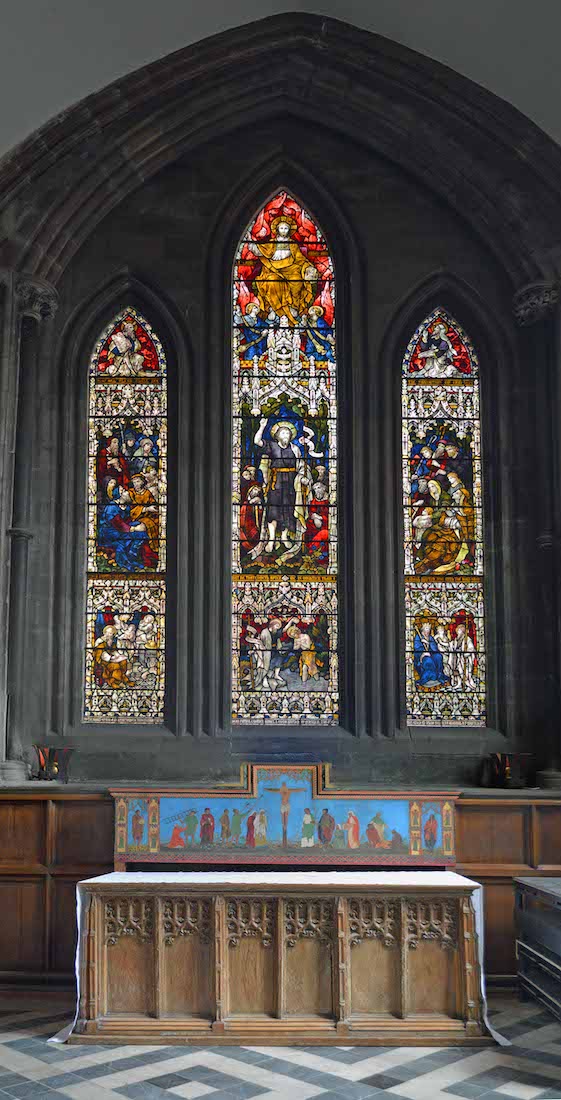
The reredos depicts a Crucifixion scene with Christ at the centre. St Mary and St John stand at the sides. St Veronica is to the right carrying her image of Jesus, and centurions further away gamble for Jesus’s cloak. The window above is a baptismal window with the verse (partly inverted?!) from Matt 3:11 : I indeed baptize you with water unto repentance: but he that cometh after me is mightier than I, whose shoes I am not worthy to bear: he shall baptize you with the Holy Ghost. PLAN
102. CHAPEL SOUTH WINDOWS
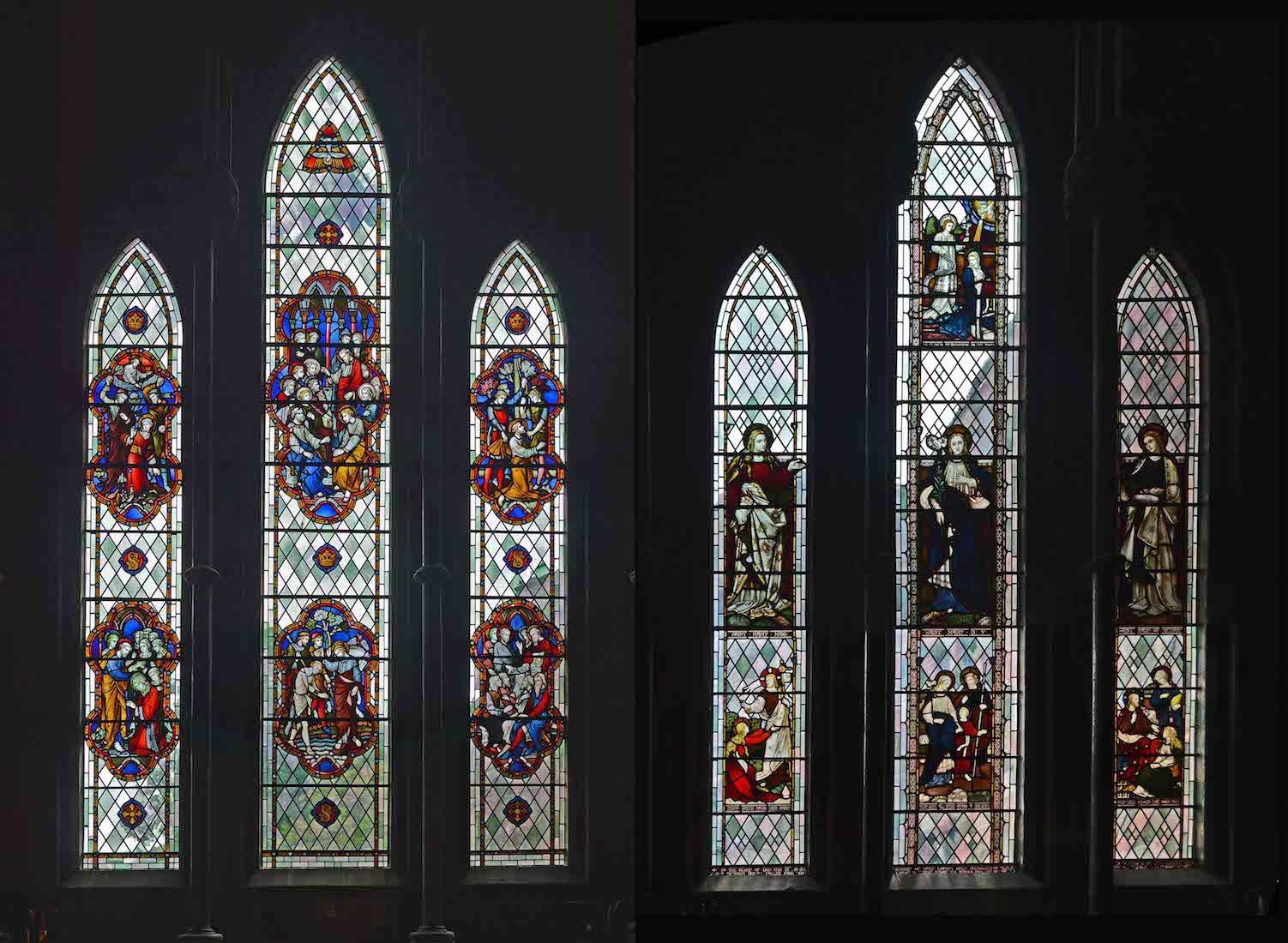
The left window on the South wall of this chapel may show scenes from the Book of Acts. Thus there appear to be depictions of the stoning of Stephen, baptising the Gentiles, and Philip and the Ethiopian. The window at right features three Marys from the New Testament: St Mary Magdalene, St Mary the mother of Jesus, and St Mary of Bethany.
103. QUIRE SCREEN AND LECTERN
We leave St John’s Chapel and move to the crossing and through the doorway in the quire screen. Looking back we see the lectern, and in the distance the West nave doors. The beautiful screen is one of a number of screens designed by architect and designer George Gilbert Scott and made by metalworker Francis Skidmore. The lectern is of traditional design featuring a brass eagle. It is from here that the scripture is read.
104. QUIRE TO HIGH ALTAR
Turning through a half-turn, we look Eastwards along the central aisle between the quire stalls to the high altar. Above us are the organ pipes. And beyond the high altar is the great East window which we have already admired.
105. QUIRE STALLS
The beautifully carved quire stalls date from the Victorian restoration, but as we shall see, they incorporate misericords from a much earlier time. The misericords are carved ledges beneath the quire seats. When the seats were raised, the misericords gave the monks support during long periods of standing during services.
106. CANOPIES
Many cathedrals have canopies which run the full length of the quire stalls, but here only the ‘special’ seats at the Western end have canopies.
107. MISERICORDS
Here is a selection of the misericords. Thirty nine of the misericords date from 1379 and include a complete set of the Labours of the Months. The subject matter includes biblical stories, mythology and folklore including ‘The Clever Daughter’ which shows a naked woman draped in a net, riding a goat and carrying a rabbit under her arm. Three of the misericords are Victorian replacements such as ‘Judas in the jaws of Satan’.
108. CATHEDRA
At the Eastern end of the quire stands the bishop’s throne, or cathedra. The word ‘cathedra’ comes from the Latin for ‘seat’, and it is from here that the title ‘cathedral’ comes. Often, as here, the cathedra is a very grand affair, but in practice it is not very often occupied!
109. ORGAN PIPES
We notice that the large Cathedral organ has two smaller pipe cases situated above the quire stalls.
110. TOMB OF KING JOHN AND THE HIGH ALTAR
The tomb of King John is the most prominent in the Cathedral: King John asked to be buried here. In his lifetime, John had often visited Worcester and had contributed to repairs after the fire of 1202. King John (1166 – 1216) was the son of Henry II of England and Eleanor of Aquitaine. He reigned as King of England from 1199 until his death. He became King of England after the death of his brother Richard I ('Richard the Lionheart'). There were many disputes between John and his barons and bishops. Because of this the nobles forced him to observe the agreement called Magna Carta, to limit his power.
111. KING JOHN IN DETAIL
Medieval effigies usually show the subject in the prime of life. The effigy on John's tomb is unique – it is a life-like image of him and is the oldest royal effigy in England dating from 1232. The tomb has been opened twice. Once in 1529 when it was described that his head was covered with a monk's cowl, however it is now thought that this was his coronation cap. Also at that time the box part of the tomb was added to match the tombs of Prince Arthur and Griffiths Ryce. The tomb was opened again in 1797 when an antiquarian study of the body was made.
112. PRINCE ARTHUR’S CHANTRY
As we now approach the High Altar, we first turn aside to enter the Chantry of Prince Arthur on our right. We have already looked closely at the other side. The cause of the Prince’s death is unknown, but it has been thought to have been either consumption, diabetes, or more recently hantavirus. Catherine herself was also taken ill with the same symptoms as Arthur but recovered. This chantry chapel to Arthur Tudor, covered in tracery and sculptures, was built in 1504. The chest tomb of the 15 year old Prince fills the chapel.
113. THE SANCTUARY
Finally we approach the High Altar with its colourful hanging and finely carved reredos. The hanging in front of the altar was made by local artists in 1969. It shows the colours of the liturgical year and represents the Cathedral’s pinnacles reflected in the waters of the river Severn flowing nearby.
114. THE HIGH ALTAR
The High Altar is dominated by Sir George Gilbert Scott's sculpted alabaster reredos depicting Christ enthroned with the Four Evangelists. This screen replaced an earlier one which now stands across the entrance to the chapel of St George. This completes our tour of Worcester Cathedral.
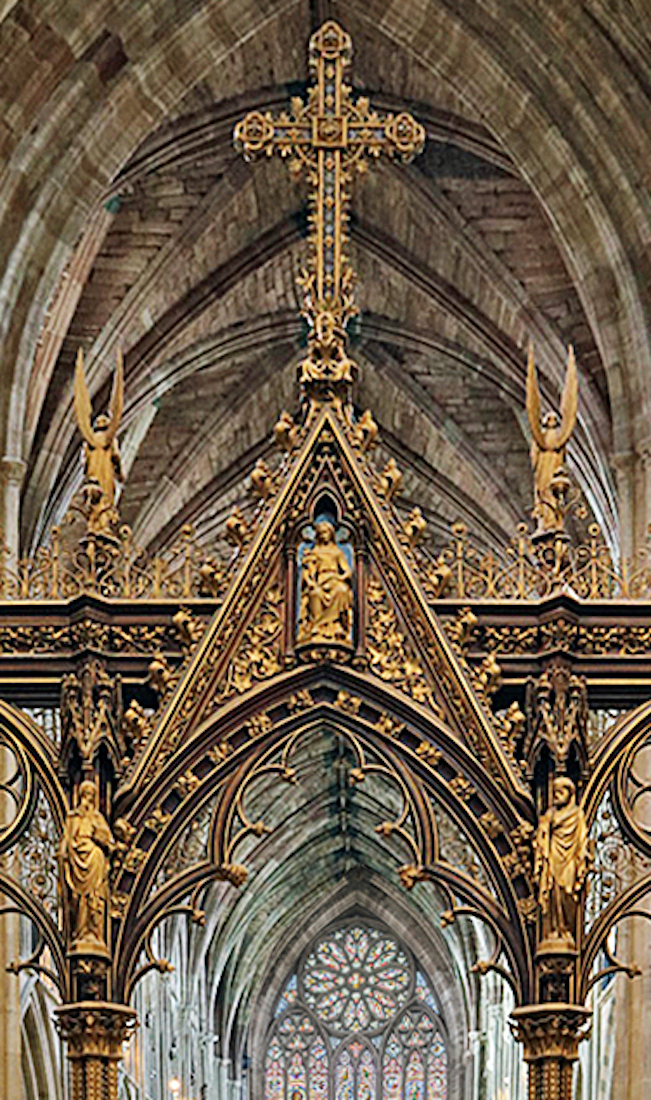
CONCLUSION
Worcester Cathedral is a wonderful cathedral – full of beauty and history. I hope you have enjoyed visiting it with me.
I am happy to receive constructive comments or corrections concerning this website. The best websites are the ones which have no errors! I am grateful to my wife Margie who came with me, and who has proof-read these pages.
With a couple of indicated exceptions, the photos on this site are all mine. However, I claim little credit for the text which has been drawn from a variety of sources, and I acknowledge these with grateful thanks. They include the ever faithful Wikipedia, the site on Worcester Monuments,
http://www.churchmonumentssociety.org/Worcestershire.html
and the Cathedral tour guide booklet. The Cathedral website is:
http://www.worcestercathedral.co.uk/
My photographs which appear on this site can also be found in higher resolution at:
https://www.flickr.com/photos/paulscottinfo/sets/
Paul Scott Site created 12 / 2017 ; reformatted 06 / 2020.

